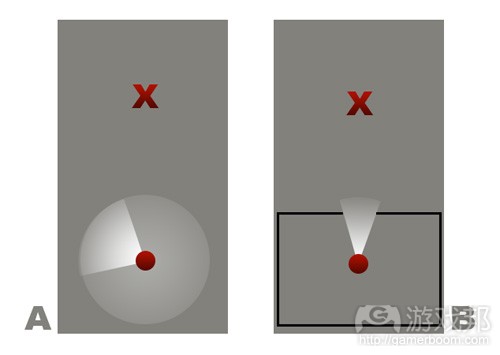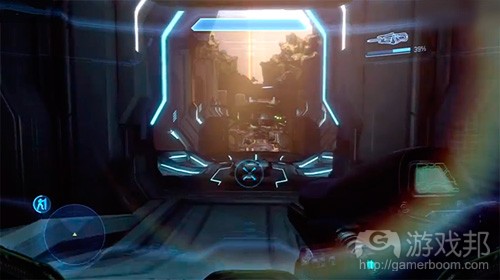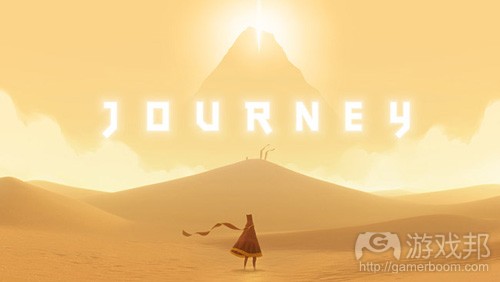开放世界可用图像定位&定心引导玩家注意力
作者:Chris Solarski
我有幸在今年3月份参加了在旧金山举办的GDC 2013大会,其中令我印象最深的是游戏开发者Steve Gaynor(前Irrational Games,The Fullbright Company联合创始人)发表的题为“游戏关卡故事讲述技巧”的演讲。
在关卡中讲述故事是一项强大的游戏设计工具,它能够让我们无需以过场动画或对话框打断玩法,向玩家传递重要的叙事元素。这种方法更具沉浸感,因为玩家会觉得自己通过视觉提示内容与叙事元素融为一体,而不是被非交互式的过场动画强行塞入信息。
Steve所提到的一个在关卡中讲述故事的技巧就是图像定位(framing),这与动态合成有关。因为电子游戏通常会让玩家自由探索环境,图像定位可用于让玩家将注意力投入游戏中的重要叙事内容。
Steve Gaynor在演讲中指出:图像定位可确保“玩家看到眼前发生的重要事件,并清楚看到其发生过程。”如下图所示,在这一重要的设计工具中,玩家(红色圆圈)在开放式电子游戏中采用的是上下视角。
在A例中,玩家会偶然错过一个重要的事件X,因为他们所看的方向错了。而在B例中,这里有个门口可用来过滤玩家的视角,令他们的注意力集中于场景中的一个特定点。
在玩游戏时,要注意你走进一个隧道或者场景正在定位一个对象或事件的情况。这种设置在《光晕》等游戏中很常见,玩家在穿过一个走廊时常会触发场景中的一个事件,这会立即让玩家预测到即将发生事件的概况。
上图是343 Industries的《光晕4》(2012),大量使用了门廊元素以指引玩家对重要事件的注意力。例如,玩家接近这个特殊门廊时,搭载着Convenant部队的运输机就突然出现了——这让玩家立即警惕即将发生的事情。如果没有这个门廊定位场景,玩家可能就会看错方向,错过可以指引方向的重要事件。
Steve Gaynor关于游戏设计的图像定位例子来自由Arkane Studios开发的《Dishonored》(2012),其中场景的碎石和建筑结构都是有意安排,以便创造一个画面。如下图所示,黑暗画面以及中间明亮画面的对比,是为了进一步引导玩家注意力,以便他们了解即将发生什么重要的事件。
Steve Gaynor提到的另一个关卡内讲述故事的要点是,图像定位的重要事件应该“总是发生于玩家屏幕的中央”。
一般而言,所有领域的美术人员都会避免将关键对象置于构图的中央,因为这种布局就像是一个抢眼的感叹号,它会让观众难以从该位置挪开眼线,探索画面的其余内容。这也正是为何在构图中常用到三分之二法则的原因。
三分之二法则。注意上图左的石峰,这在视觉上十分显眼,因为它位于画面的中央。而右图的石峰则有点偏离中央,可以让你的视线在其余画面自由探索。
回到Steve的描述,关键对象应该“总是发生于玩家屏幕的中央”,以上两图正印证了这一说法,将对象置于正中央是电子游戏引导玩家关注重要事件和对象的一个实用方法。
将对象置于画面中央,确保它占据视觉优势,例如上图《光晕4》中的例子,玩家的目标被定位于正中央,他们也就没有理由转向其他方向。
thatgamecompany推出的《Journey》也在游戏开场使用了这一设置。你最初是走上一个沙丘,在接近沙丘顶端的过程中,你会面对远处的山峰,后者因其体积和正中央的位置占据了视觉优势。
可以说,图像定位和定心(centering)的结合使用可确保开放世界游戏的玩家会在正确的时间,锁定你希望他们关注的方向。(本文为游戏邦/gamerboom.com编译,拒绝任何不保留版权的转载,如需转载请联系:游戏邦)
Framing and Centering: Directing Player Attention in Open 3D Worlds
by Chris Solarski
The following blog was, unless otherwise noted, independently written by a member of Gamasutra’s game development community. The thoughts and opinions expressed here are not necessarily those of Gamasutra or its parent company.
Want to write your own blog post on Gamasutra? It’s easy! Click here to get started. Your post could be featured on Gamasutra’s home page, right alongside our award-winning articles and news stories.
I was fortunate to attend GDC 2013 in San Francisco back in March, which turned out to be a very inspiring experience. One particular presentation that I enjoyed was by game designer was titled ‘Techniques for In-Level Storytelling’, by Steve Gaynor (formerly designer at Irrational Games, cofounder of The Fullbright Company).
In-level storytelling is a powerful tool for game design, as it allows us to communicate important narrative elements to the player without disrupting gameplay with a cutscene or scripted piece of dialogue. The result feels significantly more immersive because players feels like they alone are piecing together narrative elements from visual cues in the environment, as opposed to being fed information through non-interactive cutscenes.
A feature of in-level storytelling discussed by Steve was that of framing, which relates to dynamic composition [see my Gamasutra article for more information on dynamic composition]. Because video games allow players to explore environments freely, framing is used to focus a player’s attention on important storytelling events within a game.
As Steve Gaynor stated in his presentation: framing ensures “the player is facing an important event when it begins, and is able to see it clearly as it proceeds.” This important design tool is illustrated below, where we have a top down view of a player [red circle] in an open video game environment.
Framing creates a funnel for the player’s view, focussing there attention on a smal area within an otherwise open 3D world.
In example A, the player has accidentally missed an important event [X] because they happen to be looking in the wrong direction. While in example B, a doorway has been used to funnel the player’s view, focussing their attention on a specific point in the environment within an otherwise open 3D world.
When playing games, take note of such situations where you find yourself walking along a tunnel or the environment is framing an object or event. This device is repeatedly used in games like Halo, where the action of passing through a doorway often triggers an event within the environment, instantly giving the player an overview of what to anticipate.
343 Industries’ ‘Halo 4′ (2012) makes heavy use of doorways to focus a player’s attention on important events. For instance, a dropship carrying enemies suddenly appears just as the player approaches this particular doorway—giving the player a heads-up on what to expect up ahead. Without the doorway framing the scene, the player may have been looking in another direction, missing the important event that helps them with orientation.
343 Industries’ Halo 4 (2012), above, makes heavy use of doorways to direct player attention to important events. For instance, a dropship carrying Convenant troops suddenly appears just as the player approaches this particular doorway—giving the player a heads-up on what to expect up ahead. Without the doorway framing the scene, the player may have been looking in another direction, missing the important event that helps them with orientation.
Steve Gaynor’s example of framing in game design was from Dishonored (2012), developed by Arkane Studios, where rubble and building structures in the environment have been deliberately arranged to create a frame. As can be seen in the example below, the added feature of strong contrasts between the dark frame and bright central opening further focuses the player’s attention on where an important storytelling event is about to happen.
Use of framing in Dishonored (2012), by Arkane Studios
Another point that Steve Gaynor’s made in the context of in-level storytelling, was that the important event being framed should “always occur in the center of the player’s screen.”
Generally speaking, artists in all disciplines (except those working in portraiture) tend to avoid placing key objects at the very center of a composition because such placement works like an exclamation point—it becomes very difficult for viewers to move their eyes away from this position and explore the rest of the image. This is why the Rule of Thirds is often used as a framework for composing images.
The Rule of Thirds. Notice how the stone pinnacle in the left example is visually overpowering because of its central position within the frame. While the righthand example—with the same structure now placed off-centre—gives your eyes more freedom to explore the rest of the image.
The Rule of Thirds. Notice how the stone pinnacle in the left example, above, is visually overpowering because of its central position within the frame. While the righthand example—with the same structure now placed off-centre—gives your eyes more freedom to explore the rest of the image.
Returning to Steve’s statement, that key objects should “always occur in the centre of the player’s screen,” refers to the fact that placing objects dead centre is a very useful device in video games to further focus a player’s attention on important in-game events and objects of interest, as in the two examples below.
Centering objects within a frame ensures that the objects hold visual dominance, such as in this example from ‘Halo 4,’ where the player’s goal is positioned dead centre—leaving no doubt where the player must go next.
Centering an object within a frame ensures that it holds visual dominance, such as in the above example from Halo 4, where the player’s goal is positioned dead centre—leaving no doubt as to where the player must go next.
‘Journey’ by thatgamecompany also uses the device of centering in the game’s opening. You initially walk up a sand dune, which features interesting structures placed along the screens central vertical line. As you near the top of the dune, you’re confronted by the mountain in the distance, which is awarded visual dominance on account of its size and central position within the frame.
Journey by thatgamecompany also uses the device of centering in the game’s opening. You initially walk up a sand dune, which features interesting structures placed along the screens central vertical line. As you near the top of the dune, you’re confronted by the mountain in the distance, which is awarded visual dominance on account of its size and central position within the frame.
Framing and centering used together are therefore an invaluable tool for ensuring that players of your open-world game will always be looking in the direction that you wish them to look at exactly the right time.(source:gamasutra)
上一篇:开发者需要掌握的5大内容营销诀窍













































 闽公网安备35020302001549号
闽公网安备35020302001549号